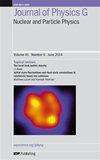Probing onset of nuclear vaporization in heavy ion collisions
IF 3.4
3区 物理与天体物理
Q2 PHYSICS, NUCLEAR
Journal of Physics G: Nuclear and Particle Physics
Pub Date : 2023-03-27
DOI:10.1088/1361-6471/acc7bc
引用次数: 0
Abstract
The onset of nuclear vaporization in heavy-ion collisions is examined in the present study. For this, we perform Quantum Molecular Dynamics (QMD) model calculations supplemented with clusterisation algorithm for fragment identification, namely Simulated Annealing Clusterization Algorithm (SACA) approach. Our results with much sophisticated SACA method show a nice agreement with experimental findings of vaporization (predicted by asymptotic behaviour of average fragment charge) in $^{16}$\textrm{O} $+$ $^{80}$\textrm{Br} and $^{16}$\textrm{O} $+$ $^{10 7}$\textrm{Ag} collisions. Further, we predicted the energy of onset of vaporization for $^{40}$\textrm{Ca} $+$ $^{40}$\textrm{Ca}, $^{84}$\textrm{Kr} $+$ $^{84}$\textrm{Kr}, $^{132}$\textrm{Xe} $+$ $^{132}$\textrm{Xe} and $^{197}$\textrm{Au} $+$ $^{197}$\textrm{Au} collisions by investigating gas/liquid content and probability of vaporization (and it's derivative) \emph{vs} incident energy behaviour. These two observables probe the critical point of nuclear vaporization in much sophisticated manner, relative to average fragment charge. Our findings on these two novel variables to predict the energy of onset of vaporization are verifiable in experiments. The influence of colliding geometry as well as role of the Coulomb interactions is also studied to understand the system size effects on the nuclear vaporization.重离子碰撞中核汽化的探测起始
本文研究了重离子碰撞中核汽化的开始。为此,我们执行量子分子动力学(QMD)模型计算,并辅以片段识别的聚类算法,即模拟退火聚类算法(SACA)方法。我们用复杂的SACA方法得到的结果与实验结果(由平均碎片电荷的渐近行为预测)非常吻合 $^{16}$\textrm{o} $+$ $^{80}$\textrm{Br} 和 $^{16}$\textrm{o} $+$ $^{10 7}$\textrm{Ag} 碰撞。进一步,我们预测了汽化起始能量 $^{40}$\textrm{Ca} $+$ $^{40}$\textrm{Ca}, $^{84}$\textrm{Kr} $+$ $^{84}$\textrm{Kr}, $^{132}$\textrm{Xe} $+$ $^{132}$\textrm{Xe} 和 $^{197}$\textrm{Au} $+$ $^{197}$\textrm{Au} 通过研究气体/液体含量和汽化概率(及其衍生物)进行碰撞 \emph{vs} 入射能量行为。这两个观测值相对于平均破片电荷,以非常复杂的方式探测了核汽化的临界点。我们对这两个预测汽化起始能量的新变量的发现在实验中是可以验证的。研究了碰撞几何形状的影响以及库仑相互作用的作用,以了解系统尺寸对核汽化的影响。
本文章由计算机程序翻译,如有差异,请以英文原文为准。
求助全文
约1分钟内获得全文
求助全文
来源期刊
CiteScore
7.60
自引率
5.70%
发文量
105
审稿时长
1 months
期刊介绍:
Journal of Physics G: Nuclear and Particle Physics (JPhysG) publishes articles on theoretical and experimental topics in all areas of nuclear and particle physics, including nuclear and particle astrophysics. The journal welcomes submissions from any interface area between these fields.
All aspects of fundamental nuclear physics research, including:
nuclear forces and few-body systems;
nuclear structure and nuclear reactions;
rare decays and fundamental symmetries;
hadronic physics, lattice QCD;
heavy-ion physics;
hot and dense matter, QCD phase diagram.
All aspects of elementary particle physics research, including:
high-energy particle physics;
neutrino physics;
phenomenology and theory;
beyond standard model physics;
electroweak interactions;
fundamental symmetries.
All aspects of nuclear and particle astrophysics including:
nuclear physics of stars and stellar explosions;
nucleosynthesis;
nuclear equation of state;
astrophysical neutrino physics;
cosmic rays;
dark matter.
JPhysG publishes a variety of article types for the community. As well as high-quality research papers, this includes our prestigious topical review series, focus issues, and the rapid publication of letters.

 求助内容:
求助内容: 应助结果提醒方式:
应助结果提醒方式:


